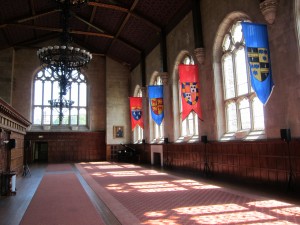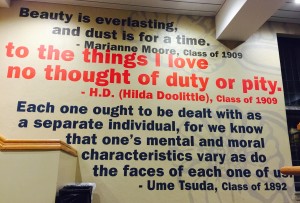During the semester, students will be responsible for four formal writing assignments connecting public history theory and method to their interests in campus histories. All written assignments are due by noon (12pm) Fridays unless otherwise noted, as follows:
- Archives reflection paper | Due Friday, February 12
- Documenting Bryn Mawr history survey | Due Friday, March 18
- Public History proposal topic and bibliography | Due Friday, April 8
- Final Project: A Public History Proposal for Bryn Mawr College | Due Friday, May 13 by 12:30pm (senior deadline: 5:00pm, Saturday, May 7)
Assignments 3 & 4: A Public History Proposal for Bryn Mawr College
- 1 page abstract + bibliography due Friday, April 8 (10%)
- 10-12 page proposal paper** due Saturday, May 9 by 5 pm (seniors) / Friday, May 13 by 12:30pm (25%)
What would be an effective public history project on Bryn Mawr’s campus (literal or virtual)? Drawing on our shared course readings and original research into Bryn Mawr College histories, you will use this final paper to propose a meaningful project of your choosing. You will be evaluated on your ability to make connections and note contrasts among course readings and use these findings to identify problems in the area of campus histories, generate analytical questions, and develop an original proposal that uses public history to convey the historical significance of your questions.
The final project will incorporate three major pieces: imagination (that is, what is your idea? what campus history topic deserves further research?), illustration (example(s) of potential research), and conversation with the fields of public history and/or archives.
** papers may take many forms; each student will meet with me individually in late April to discuss the format that best suits their final project topic.
Assignment 2: Bryn Mawr College History Survey, due March 18 (list+ 2-3 pages)
Public historians are often tasked with collecting data to assess the significance of historic areas or further understanding of how local histories are commemorated. In what ways is Bryn Mawr’s history manifested in physical forms (plaques, statues, names etc.) on campus and how aware are students of these landmarks? These historic signals tell stories and point out facts.
For your second formal writing assignment, your task is collect a list** of visible traces of Bryn Mawr College History on campus. Paired with your list (of at least 5-10 items), you will submit a short essay reflecting on one of the items on your list and the history it relates. The best papers will draw selectively from Bryn Mawr research resources and digital collections, and our shared readings on public history, monuments, and memorials to illustrate your own argument and experience of surveying the visible histories embedded on Bryn Mawr’s campus.
** Your list should name each “trace” you discover, as well as the following details to the extent you can determine (or questions you want to ask): location, type, date, creator, historic use, current use, notes and/or photos (optional).
Assignment 1: Archives Reflection Paper, due February 12 (2-3 pages)In her 2004 article, “Documenting Communities of Practice,” Karen F. Gracy argues:
creators of documents, users of documents, and archivists form a community of practice – the archival environment – for which social interaction creates meaning and defines values.
This community of practice often intersects with the work of public history.
For your first formal writing assignment, your task is to reflect on a site visit(s) to the Bryn Mawr College Archives, the Library Company of Philadelphia, and/or the John J. Wilcox, Jr. Archives at the William Way Community Center. In addition to thinking critically about the materials you encounter in the archive, you will aim to cultivate a critical awareness of the archival environments we encounter. The best papers will draw selectively from our shared readings to illustrate your own argument and experience of the archive(s).


